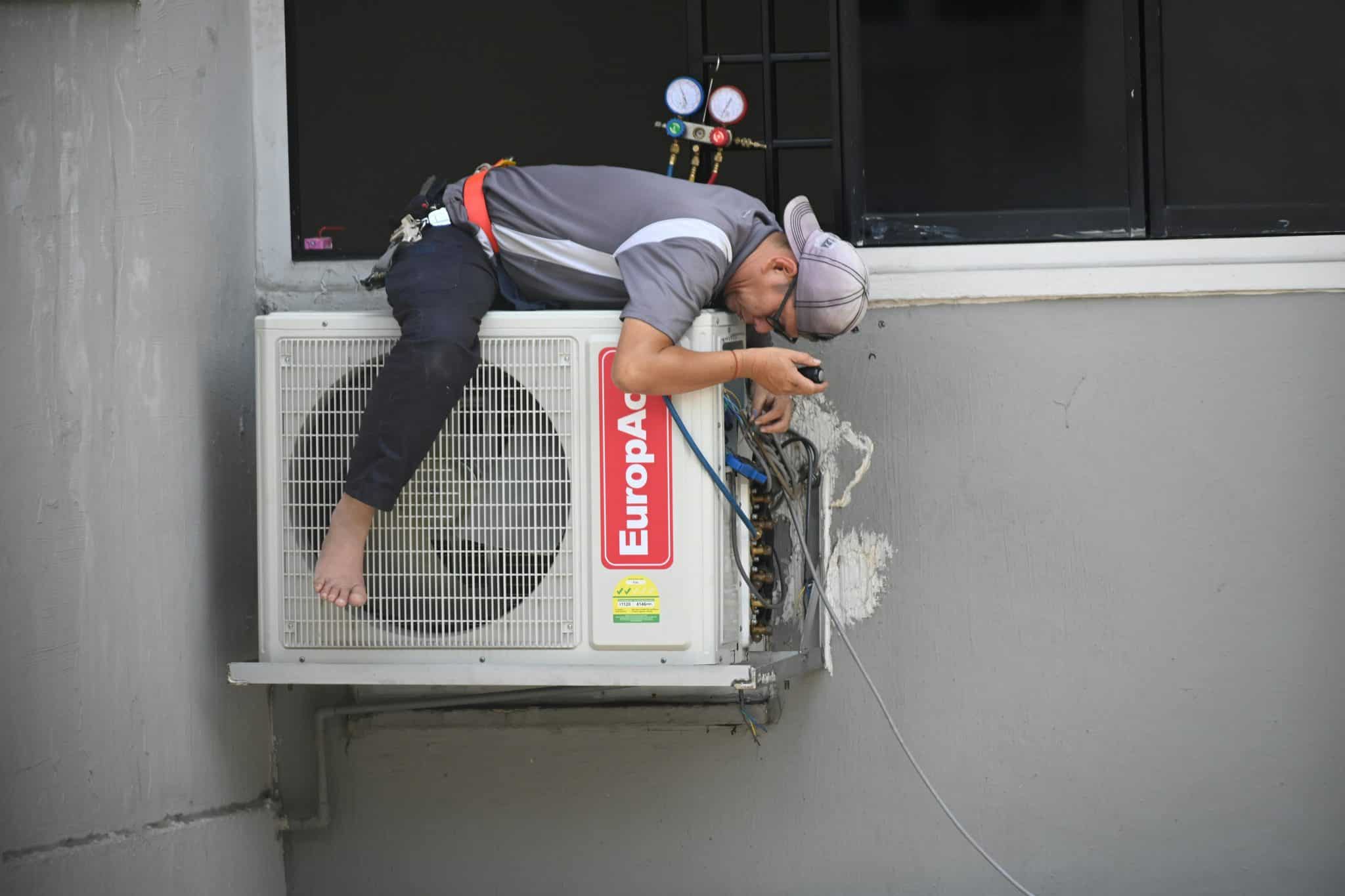Heating, Ventilation, and Air Conditioning (HVAC) systems play a critical role in modern buildings by regulating indoor thermal comfort and air quality. But, are you really up to speed with the system’s requirements and effective installation protocols?
This guide provides you with a comprehensive technical overview of HVAC systems, from core principles of thermodynamics and fluid mechanics to key components and configurations.
Introduction
HVAC systems are integral to residential, commercial, and industrial infrastructure, providing thermal comfort, indoor air quality (IAQ), and humidity control. However, the design and operation of HVAC systems require multidisciplinary knowledge, combining thermodynamics, heat transfer, fluid dynamics, control systems, and increasingly, data analytics and IoT technologies.
System Classification
HVAC systems are broadly classified based on their configuration and functionality and while some companies such as Goodman AC offer a variety of systems, that’s not always the case.
1. Centralized Systems
- Chilled Water Systems: Employ chillers to generate chilled water, which is circulated via pumps to air handling units (AHUs) or fan coil units (FCUs).
- Boiler-Based Heating Systems: Use boilers to provide hot water or steam for heating.
2. Decentralized Systems
- Split Systems: Include an outdoor condensing unit and an indoor air handler or evaporator coil.
- Packaged Units: Combine heating and cooling components in a single outdoor cabinet.
- Ductless Mini-Splits: Provide zoned heating/cooling without ductwork.
3. Hybrid and VRF Systems
- Variable Refrigerant Flow (VRF): Utilize inverter-driven compressors to modulate refrigerant flow based on load, offering high efficiency and zoning flexibility.
- Hybrid Systems: Combine traditional gas heating with heat pump operation for seasonal efficiency.
Fundamental Components
Fundamental Components
The core functionality of any HVAC system depends on a set of integrated mechanical and electrical components that work together to manage temperature, humidity, air movement, and indoor air quality.
Compressor
At the heart of most HVAC systems is the compressor, which is responsible for circulating the refrigerant through the system and facilitating the heat exchange process. The compressor increases the pressure and temperature of the refrigerant vapor, enabling it to flow through the condenser coil where heat is released.
Depending on the application and system capacity, different types of compressors may be used, including reciprocating, scroll, screw, and centrifugal designs. Each has its own efficiency characteristics, operating range, and suitability for particular system scales, with centrifugal compressors typically reserved for large-scale commercial or industrial applications.
Heat Exchangers
Another essential set of components are the heat exchangers, primarily the evaporator and condenser coils. The evaporator coil is typically located inside the air handler or furnace and is responsible for absorbing heat from the indoor air as the refrigerant evaporates within it. This process cools the air before it is recirculated throughout the building.
Conversely, the condenser coil, located in the outdoor unit, expels the heat absorbed from inside to the ambient environment. These coils are commonly constructed from copper tubing with aluminum fins, as these materials offer high thermal conductivity and durability, though alternative materials like microchannel aluminum coils are increasingly used for their compact form and improved heat transfer efficiency.
Expansion Device
Regulating the flow of refrigerant through the system is the job of the expansion device, which can be a thermostatic expansion valve (TXV), capillary tube, or an electronic expansion valve (EEV). This device meters the amount of refrigerant entering the evaporator coil based on the load conditions and ensures optimal heat absorption by maintaining the correct level of superheat.
Electronic expansion valves offer more precise control compared to mechanical options and are increasingly used in modern systems for improved efficiency and responsiveness.
Air Handling Unit
The air handling unit (AHU) serves as the central hub for air distribution in larger HVAC systems. It houses key components such as fans, filters, heating and cooling coils, and often humidification or dehumidification elements. The AHU draws in outside air or recirculates indoor air, conditions it by passing it over heating or cooling coils, and then distributes it throughout the building via ductwork.
In residential systems, a similar function is performed by the air handler or furnace, which may also include a blower motor and integrated coil.
Controls and Sensors
Another critical component category involves controls and sensors. These include temperature sensors, pressure transducers, humidity sensors, CO₂ detectors, and programmable controllers that regulate the operation of the entire HVAC system. The thermostat, while a user interface device, also plays a pivotal role by initiating heating or cooling cycles based on indoor setpoints.
More sophisticated systems use Direct Digital Controls (DDC) or are integrated into Building Management Systems (BMS), which enable real-time monitoring, remote control, and data analytics for predictive maintenance and energy optimization.
Thermodynamic Principles
1. Refrigeration Cycle
Most HVAC systems rely on the vapor-compression refrigeration cycle:
- Evaporation: Low-pressure liquid refrigerant absorbs heat and evaporates.
- Compression: Vapor is compressed to a high-pressure, high-temperature state.
- Condensation: Heat is rejected to the environment; refrigerant condenses.
- Expansion: Liquid refrigerant passes through an expansion valve, reducing pressure.
2. Psychrometrics
Understanding air properties is crucial for HVAC control:
- Dry-bulb Temperature
- Wet-bulb Temperature
- Relative Humidity
- Enthalpy
- Dew Point
Psychrometric charts are used to design processes for sensible and latent heat exchange.
Load Calculations
Accurate load calculations are essential to the proper design and sizing of HVAC systems, ensuring that equipment operates efficiently while maintaining occupant comfort.
The heating and cooling loads of a building are influenced by a variety of factors, including the thermal characteristics of the building envelope, the number and behavior of occupants, internal heat gains from equipment and lighting, infiltration of outdoor air, and the impact of solar radiation through windows.
These calculations are typically performed using established methodologies such as ACCA’s Manual J for residential applications or Manual N for light commercial buildings. For more complex or larger projects, engineers often reference the ASHRAE Handbook – Fundamentals, which provides detailed procedures for calculating sensible and latent loads.
Ventilation requirements must also be considered, especially in commercial settings, where compliance with standards like ASHRAE 62.1 ensures sufficient outdoor air exchange to maintain indoor air quality.
Over- or under-sizing HVAC systems due to inaccurate load estimation can result in reduced energy efficiency, short cycling, humidity control issues, and premature equipment wear, underscoring the critical importance of precise and comprehensive load analysis during the design phase.
Control Strategies
Advanced control strategies improve efficiency and responsiveness:
1. Thermostatic Control
Basic on/off or proportional-integral-derivative (PID) control based on indoor temperature.
2. Zoning
Divides a building into thermal zones, each with independent control—used in VAV systems and mini-splits.
3. Economizer Control
Uses outdoor air for “free cooling” when ambient conditions permit.
4. Demand-Controlled Ventilation (DCV)
Modulates ventilation based on occupancy sensors (typically CO₂) to reduce energy use.
5. Building Automation Systems (BAS)
Centralized control and monitoring of HVAC, lighting, and other systems via BACnet, Modbus, or proprietary protocols.
Performance Metrics
Key efficiency indicators include:
|
Metric |
Definition |
Units |
|---|---|---|
|
SEER |
Seasonal Energy Efficiency Ratio |
BTU/W·hr |
|
EER |
Energy Efficiency Ratio |
BTU/W |
|
COP |
Coefficient of Performance |
Unitless |
|
HSPF |
Heating Seasonal Performance Factor |
BTU/W·hr |
|
IPLV/NPLV |
Integrated Part Load Value |
BTU/W (part-load performance) |
ASHRAE 90.1 and local codes specify minimum efficiency thresholds.
8. Energy Optimization and Sustainability
Modern HVAC design emphasizes sustainability and energy savings:
High-Efficiency Equipment
Inverter compressors, ECM motors, and low-GWP refrigerants (e.g., R-32, R-454B) reduce operational impact.
Energy Recovery Ventilation (ERV/HRV)
Captures energy from exhaust air to condition incoming fresh air.
Thermal Storage
Chilled water or ice storage systems shift cooling loads to off-peak hours.
Integration with Renewable Energy
- Solar thermal for heating/domestic hot water
- PV integration with HVAC-powered battery systems
LEED and WELL Standards
HVAC performance contributes significantly to green building certifications and occupant wellness scoring.
Conclusion
HVAC systems are a sophisticated integration of mechanical, electrical, and control subsystems. As energy codes tighten and comfort expectations rise, HVAC design must prioritize efficiency, flexibility, and resilience.
Advanced control, sustainable refrigerants, and integration with smart building systems represent the future of HVAC technology. Technicians, engineers, and designers must continuously adapt to evolving standards and innovations to meet the growing demand for optimized indoor environments.








